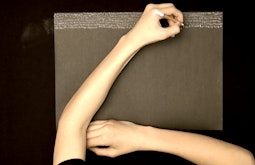"Hau is the first in a series of four moving image works, under the project title Ō Ratou Tāonga Katoa, or "all our treasures". This term was a critical clause exploited by the British in our Nation's founding document, The Treaty of Waitangi. The project explores different aspects of the historical, social, and multicultural tensions at play within our connection to place and the fabric of our collective identity.
In Hau, Ngāi Tahu kaiwhakairo (carver), Fayne Robinson carves a pear fruit from the wood of a pear tree planted in the year 1846 at the south end of Riccarton House by an early European settler, John Deans. The patterns Robinson carves represent his interpretations of the kaupapa of Robinson’s ancestor, Tāwhaki, and Tāwhaki’s journey to acquire knowledge of his ancestors. Responding to visual and audio documentation of Robinson carving, the film moves variously between realism and abstraction, invoking a sense of displacement of time.
Across cultures, the symbol of the pear often represents unity, fertility and longevity. The child in the film places the pear halves back together in a gesture of reconciliation. A narrated passage at the conclusion of the film from Tarkovsky’s film, Stalker (1979), is narrated by Kate Belton’s Grandfather, who was also a carver. In a voice made brittle with age, the narrator reminds us that the old ways are not always the way forward, and that there is strength to be found in the reflexiveness and vulnerability of youth.
Hau was conceived in the wake of the Christchurch earthquakes and subsequent city rebuild, which provides us with an opportunity to fulfill our commitments to Tāngata Whenua. Setting the film in a contemporary context provokes discourse around the themes of intergenerational loss, trauma and recovery. These themes remain relevant in a city still in recovery and are central to the healing of place and people. We hope that the project acts to bring people together, affirming their sense of value for our place and sense of belonging."
Hau (2016)
Other works by Kate Belton

Kate Belton
The Lie of the Land (2021)
A concept trailer for a longer work. A farmer’s dystopian battle against an unforgiving landscape.

Kate Belton
Palimpsest (2012)
A boy writes coordinates from inside the original Ōtautahi / Christchurch CBD red zone, where major demolition occurred after the 2011 earthquake.